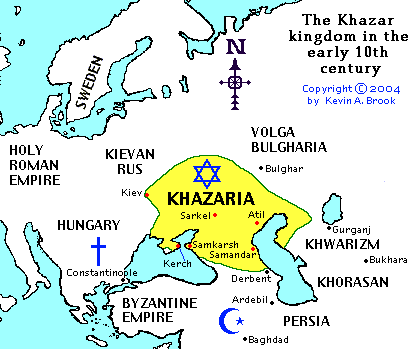 |
Hope of Israel Ministries (Ecclesia of YEHOVAH):
Jewish Origins: The Khazar Empire
|
Christian Zionists have a perplexing dilemma on their hands since today's Jews are not "God's chosen people" of the Bible but rather a Turkic people from Asia having no substantial connection to the characters and tribes described in the holy books. |
by Freydis
["Indeed I will make those of the synagogue of Satan, who say they are Jews [Israelites] and are not, but lie -- indeed I will make them come and worship before your feet, and to know that I have loved you (Revelation 3:9)."]
As is often the case, fact is more fascinating (and fantastic) than fiction, so it is with Jewish history. Certainly one of the most significant and truly astounding stories has to do with who the Jews really are and where they come from. And in this regard it's widely accepted as fact that Jews all originated in the Levant, as their holy book states and as contemporary Zionism expounds as justification for occupation of the modern state of Israel and surrounding territories.
This may be true for the Sephardim (meaning Jews from Spain) that make up less than 20% of the total today, and probably arrived in southwestern Europe from the Levant during the Roman Empire. But a growing body of historical and archeological evidence shows this is not the case for the vast majority of Jews alive today, the 80%+ called Ashkenazim. So, although Christians and most Jews alike believe that the Eastern Mediterranean region is the homeland of their genetic ancestors, this egregious error confuses religious documents with a true scientifically-derived origin.
That scientifically-verified origin indicates that, as incredible as it may initially seem, the majority of the Jews in the world today actually originated from a group of Turkic people from Asia living between the Caspian and Black Seas in an Empire known as Khazaria, from about the year 700-1200. Khazaria was a formidable and populous power that dominated regional trade routes and accumulated great wealth. Their conversion to Judaism marked one of the most momentous events of the past two millennia. Hundreds of years later the decline and fall of Khazaria pushed Jews into new settlements in Eastern Europe, creating the basis of today's Jewish population that lives primarily in the United States and Israel.
The Khazar Empire, as it slowly emerges from the past, begins to look like the most cruel hoax which history has ever perpetrated. [1, pg. 17]
Khazaria Rediscovered
The approximate boundaries (yellow area) of 10th century Khazaria are shown below. Although a mystery for many years the pieces of the Khazaria puzzle are now beginning to fit into place as new archeological evidence emerges to substantiate the scattered written accounts of travelers and proselytizers. Since the Khazar people were semi-nomadic and mostly illiterate they didnít leave much behind for us to study, but outsiders from civilized parts of the world, like Byzantium and Arab lands, did travel to Khazaria and did leave records of their experiences. So, from historical documents we know that the capital of Khazaria is Itil (Atil) but, unfortunately for modern historians and archeologists, only a few of the most important buildings were actually built of stone and brick, the remainder were tents or similar temporary structures. Nonetheless difficult doesnít mean impossible and in 2008 a Russian archeologist, Dmitry Vasilyev from Astrakhan State University, discovered burnt-brick ruins near the city of Astrakhan at the mouth of the Volga River and the Caspian Sea in Russia. The archeological remnants match historical descriptions of the lost capital of Khazaria. [2]
 |
Conversion to Judaism
Originally Khazaria was just another brutal, warlike clan-empire ruled by the Kagan priest/kings and characterized by a variety of intensely pagan belief practices. Yet by about the year 1000 the Khazars were using the Hebrew alphabet in official documents.
Under the leadership of kings Bulan and Obadiah, the standard rabbinical form of the Jewish religion spread among the Khazars. King Bulan adopted Judaism in approximately the year 838, after supposedly holding a debate between representatives of the Jewish, Christian, and Muslim faiths. The Khazar nobility and many of the common people also became Jews. King Obadiah later established synagogues and Jewish schools in Khazaria. [4]
The Khazar conversion to Judaism is not something that would have happened without great consideration. Why did they do it? In order to understand the reasons Khazaria converted to Judaism itís important to recognize that, first of all, Khazaria was a major transit region. The silk route and other critical trade paths went directly through Khazaria. The main source of revenue for the empire came from commerce and particularly from Khazar control of the east to west trade routes that linked the Far East with Byzantium as well as the north to south corridors connecting the Arab empire with northern Slavic lands. So, much of their fortune was made as merchants and from taxes on products moving from one point to another. Further income was squeezed from neighboring subordinate tribes through intimidation and extortion. [3, p. 17] This maintained the fiscal strength of the empire throughout the 8th, 9th, and 10th centuries, and made the people well versed in certain traits and tactics that were to come in handy in the future.
By the nature of the geography Khazaria also served as a very important buffer between conflicting regions, of particular benefit to Byzantium, by blocking the advances of the Muslims from the southeast, the Rus barbarians from the north, and the rough nomadic tribes from the east. As a merchant empire and a transit point a certain element of neutrality was important for relations with neighboring powers. The other major impetus was the necessity of unifying an empire composed of cutthroat rabble practicing various, and no doubt contradictory, pagan beliefs.
At the same time, their intimate contacts with Byzantium and the Caliphate had taught the Khazars that their primitive shamanism was not only barbaric and outdated compared to the great monotheistic creeds, but also unable to confer on the leaders the spiritual and legal authority which the rulers of the two theocratic world powers, the Caliph and the Emperor, enjoyed. Yet the conversion to either creed would have meant submission, the end of independence, and thus would have defeated its purpose. What could have been more logical than to embrace a third creed, which was uncommitted towards either of the two, yet represented the venerable foundation of both? [1, p. 59]
After conversion Jews from the surrounding regions travelled to Khazaria to escape persecution and enjoy camaraderie.
Disintegration and Dispersal
A critical historical event that had a major impact upon the Khazar Empire was another conversion to monotheism, that of the raiding Rus tribes to Christianity. In the year 988 Prince Vladimir studied all of the major monotheistic religions and picked Orthodox Christianity because he was impressed with Byzantiumís wealth and didnít want to have to give up eating pork (and alcohol) as the other two monotheistic religions required. Prince Vladimir was nothing if not pragmatic.
After the Rus adopted Christianity they aligned with Byzantium and decisively defeated the now mostly sedentary and less warlike Khazars at their fortress of Sarkel in the year 965, and then their capital Itil shortly afterwards. Yet that wasnít the ultimate ruin of Khazaria. It was actually the nomadic assaults from the Mongol hordes of Genghis Khan in the 13th century that fractured and scattered the Khazar Jews to the west. Finally the Black Death plague of 1347-1348 mopped up the scattered elements already reduced to replaying their barbaric past.
Its population was largely absorbed by the Golden Horde which had established the centre of its empire in Khazar territory. But before and after the Mongol upheaval the Khazars sent many offshoots into the subdued Slavonic lands, helping ultimately to build up the great Jewish centres of eastern Europe. [1, p. 141]
The Khazar Jews fled their homeland for safer and more stable regions of Eastern Europe such as Poland, Hungary, and the Ukraine. If we can guess at how many people lived in Khazaria we can get an idea of the size of Eastern Europe's early Jewish population:
We remember that the Arab sources speak of Khazar armies numbering three hundred thousand men involved in the Muslim
-- Khazar wars; and even if allowance is made for quite wild exaggerations, this would indicate a total Khazar population of at least half a million souls. Ibn Fadlan gave the number of tents of the Volga Bulgars as 50,000, which would mean a population of 300,000-400,000, i.e., roughly the same order of magnitude as the Khazars. On the other hand, the number of Jews in the Polish -- Lithuanian kingdom in the seventeenth century is also estimated by modern historians at 500,000 (5 per cent of the total population). These figures do not fit in too badly with the known facts about a protracted Khazar migration via the Ukraine to Poland-Lithuania, starting with the destruction of Sarkel and the rise of the Piast dynasty toward the end of the first millennium, accelerating during the Mongol conquest, and being more or less completed in the fifteenth-sixteenth centuries -- by which time the steppe had been emptied and the Khazars had apparently been wiped off the face of the earth. [1, p. 150-151]So, Khazaria Jews formed the Eastern European Jewish population.
According to the article "Statistics" in the Jewish Encyclopaedia, in the sixteenth century the total Jewish population of the world amounted to about one million. This seems to indicate, as Poliak, Kutschera and others have pointed out, that during the Middle Ages the majority of those who professed the Judaic faith were Khazars. A substantial part of this majority went to Poland, Lithuania, Hungary and the Balkans, where they founded that Eastern Jewish community which in its turn became the dominant majority of world Jewry. [1, p. 151]
A strong identity wrapped in a code of religious separatism largely kept the people intact despite enduring dispersion within other nations and empires. They took over niches they learned from late Khazaria times, mostly financial and merchant careers, but also the crude and unregulated medical professions allowed by the Christian governments. As the surrounding Christian populations grew the Jewish enclaves did not increase proportionally and gradually the Jews from Khazaria became geographically compressed from living in towns and villages (shtetl), into legally circumscribed regions of cities (ghettos). As cities grew the more organized Christian authorities established laws that restricted Jewish activities and forced them to live in proscribed parts of the city.
To the Christian Europeans the ghetto Jews were a scary looking people with very odd customs and beliefs, as written in the Bible they are ďa peculiar peopleĒ (Deuteronomy 14:2 King James version). And since they couldnít intermix it was very much a black and white issue for both sides, them and us; this deeply ingrained mentality even remains today. The stereotypical Jewish jobs such as doctors, dentists, and moneylenders arose because those occupations were outside the mainstream as defined by the Christian (Catholic) Church. Jewish authorities liked the ghetto, it neatly meshed with their religious views and it was easy to claim persecution and rally their flock around a unique identity under real, or perceived, siege. The ghetto restricted cultural development while keeping their beliefs separate from the influences of the outside. And Christian authorities liked the ghetto because they could minimize Jewish competition and contain the different faith.
The modern flag of the state of Israel features the "star of David" symbol. An interesting side note concerns the six-pointed "Star of David" symbol -- it probably originated from Khazaria rather than the Middle East.
 |
 |
|
"Shield of David" |
Khazar Soldier Being Vanquished |
According to one theory, the six-pointed "shield of David" which adorns the modern Israeli flag, started to become a national symbol with David al-Roy's crusade. "Ever since," writes Baron, "it has been suggested, the six-cornered 'shield of David', theretofore mainly a decorative motif or a magical emblem, began its career toward becoming the chief national-religious symbol of Judaism. Long used interchangeably with the pentagram or the 'Seal of Solomon', it was attributed to David in mystic and ethical German writings from the thirteenth century on, and appeared on the Jewish flag in Prague in 1527." [1, p. 137]
In fact, the hexagram originated long ago as a symbol of mystical paganism, and only more recently, somewhere between the age of Khazaria and the Jewish dispersal, has it been associated with Judaism. This evolution makes perfect sense as Khazaria was a stew of pagan beliefs before it officially became a unified Jewish nation.
From Eastern Europe to Israel
This was the steady state of affairs until the 18th century when Napoleon swept through Europe on his way to Russia and broke open the stagnant and inbred ghettos with new laws that usurped religion in favor of economy. Then in the last part of the 19th century Theodor Herzl dreamed up the nationalist theocracy of Zionism and sold it to Jewish and Christian leaders who found it attractive for their own reasons. Zionism offered the Jews their own state and a chunk of real estate in Palestine, which was chosen because it matched the religious texts and the land was politically feasible to acquire. European Jews gradually moved into what is now the State of Israel as another conqueror arrived on the scene who was less charitable towards the Jews than Napoleon, Adolph Hitler, accelerating the flow of Jews into British controlled Palestine.
Conclusion
Except for brief historical exceptions Judaism is not a proselytizing religion, a critical difference between the other two major historical monotheistic religions of Christianity and Islam. Judaism is rather a matrilineal tribal faith considered to be a long and unbroken chain of a single people that have wandered out, around, and now back to the Eastern Mediterranean with the advent of Zionism and the modern state of Israel. But the classic storyline of Jewish origins has never been able to explain how hundreds of thousands of Jews, supposedly from the Levant, remarkably all appeared in villages across Eastern Europe beginning about the 13th and 14th centuries, with virtually nowhere else of any comparable population. However, the rise and fall of Khazaria does explain the situation perfectly well.
Historical facts and archeological evidence demolish the established origins and assumed racial and ethnic character of the Jews. The vast majority of Jews alive today are not descendants of the Middle East and therefore the pejorative term anti-Semitism is effectively meaningless because most Jews are not a Semitic (Middle Eastern) people. Not that the term "anti-Semitism" made much sense to begin with since it was always selectively employed to refer to Jewish but not Arab Semites! Christian Zionists as well have a perplexing dilemma on their hands since today's Jews are not "God's chosen people" of the Bible but rather a Turkic people from Asia having no substantial connection to the characters and tribes described in the holy books.
References
[1]. The Thirteenth Tribe, by Arthur Koestler, Random House publishing, (first American edition), 1976.
[2]. Russian archaeologist finds lost capital of Khazar empire, AP via MSNBC, September 21, 2008.
[3]. A History of Russia, sixth edition, by Nicholas V. Riasanovsky, Oxford University Press, 2000.
[4]. An Introduction to the History of Khazaria, by Kevin Alan Brook, Khazaria.com, September 2004.
Resources
Khazaria.com "A Resource for Turkic and Jewish History in Russia and Ukraine"
Holology: The Jewish State by Theodor Herzl, 1896
Europa Universalis II & III, a fun and fascinating computer game of European history.
|
Hope of Israel Ministries -- Preparing the Way for the Return of YEHOVAH God and His Messiah! |
|
Hope of Israel Ministries |
 |
Scan with your Smartphone for more information |